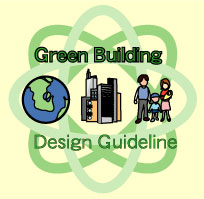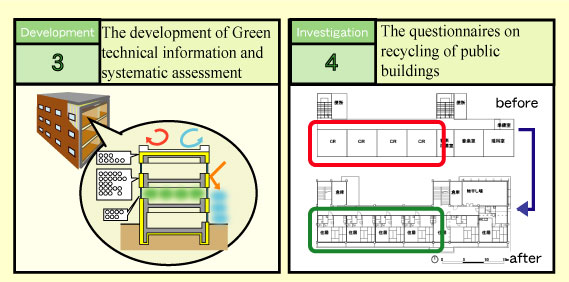 |
 |

|
Representative:Terukazu Takeshita -Faculty of Human-Environment Studies
|
| ■Purpose of the Present Study for Promoting Green Building Design |
| We did a study for the creation of a green building guideline for a new campus for Kyushu University in 2000 and 2001. Nineteen members, majoring in architecture, building science and civil engineering, carried out this study. Since this study project was finished, Takeshita laboratory, the representative group for this study has been at doing research work on new themes of green building design. For the promotion of Green Building in Japan, green building guidelines and assessments of environmental design are being made in local governments and large-scale architectural firms. It should be noted that environmental design in small-scale an architectural offices is based on individual experience and knowledge. It may be said that it is difficult to judge adaptability and availability of selected environmental techniques objectively. The design-support information system is indispensable for realizing green buildings, and this system provides the technical information and systematic assessment of the embodiment, which meets the three phases of design processes, concept, preliminary design, and architectural design. We study the technical information system to support green building design for architect firms. According to developing interactive system, new technical information is reconstituted as design knowledge of one region, and it is possible to create a green building for a specific region. |
■Conception of Green Building on This Study |
|
| Green Building Principles | Green Building Design Manual |
| I Minimum consumption through the building life cycle II Minimum environmental load III Environmental ecosystem conservation IV Safety, Comfort and high quality life space V Coordination between building performance and use VI Environmental performance and cost balance |
1. Energy Efficiency 2. Water Circulation System 3. Recycle, Reuse and Reduce 4. Adjustment with the Building Use,Analysis of Site Environment 5. Adoption of Healthy, Safety and Sustainable Material 6. Building Longevity through Maintenance 7. Construction Consumption Reduction,Prevention of Air Pollution 8. Improved Indoor Air Quality 9. Efficient Maintenance 10. Amenies for Users,Establishment of Commissioning System 11. Efficiently Dismantling and Reduction of Construction Waste 12. Reduction of Life Cycle Cost 13. Contribution to Regional Prosperity |
| ■Present Study Themes for Development of Green Building Design Guideline | |
 |
|
 |
|
 |
|
 |
 |